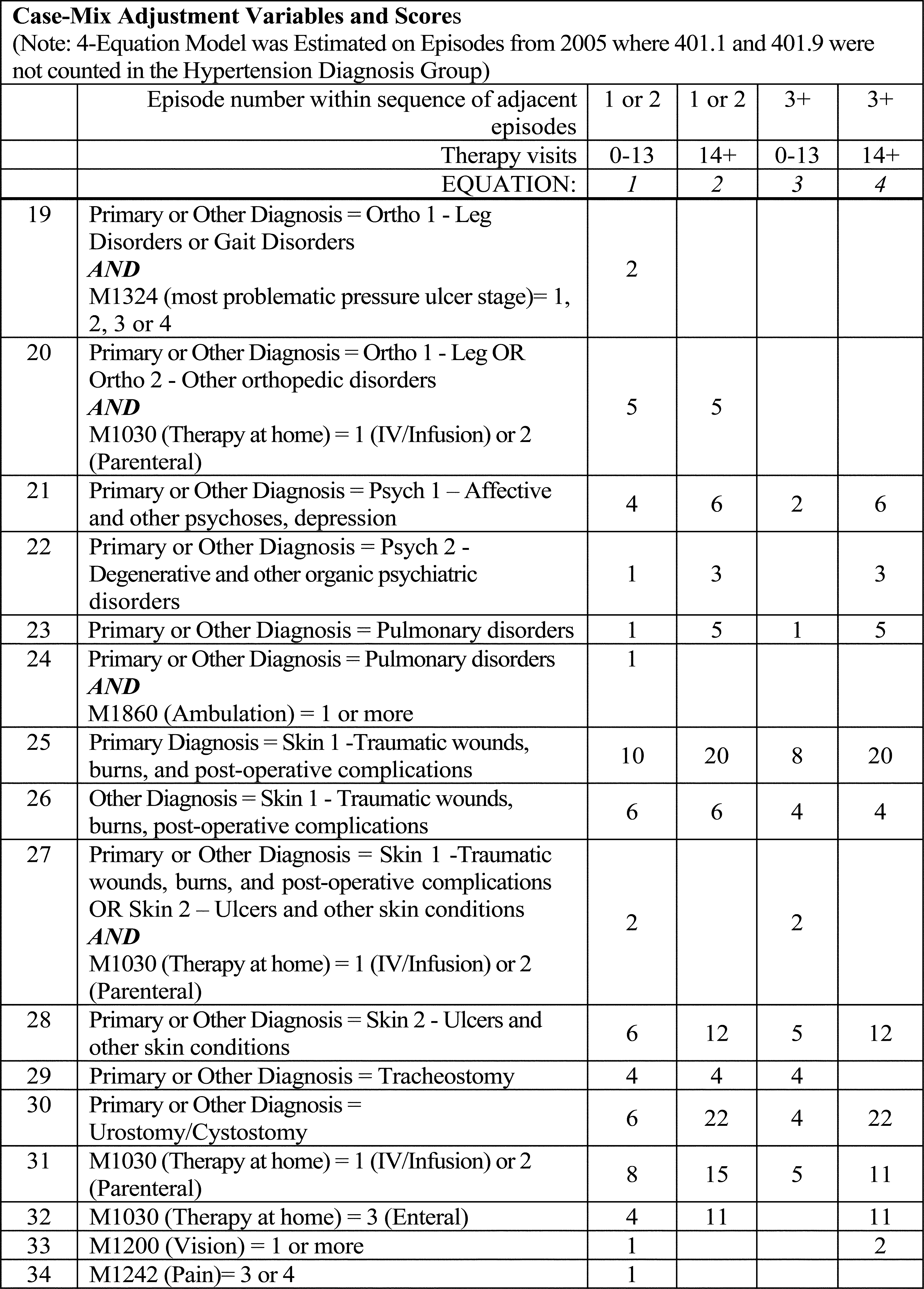Table of Content
We did not receive comments on this proposal and therefore are finalizing the reassignment of diagnosis code J18.2 to respiratory 2 when listed as a secondary diagnosis. Post-PDGM, there are 432 different LUPA scenarios, with visit thresholds ranging from two to six. CMS’s recently unveiled home health proposed payment rule for 2021 maintains that more complex framework. We have created a PDGM Calculator so when we do OASIS review for agencies, we can provide key information like the reimbursement calculation, HIPPS code, Case Mix, and also LUPA Threshold.
Our clinical advisors reviewed the ICD-10-CM diagnosis code U09.9 (post COVID-19 condition, unspecified), which is currently assigned to the comorbidity subgroup, respiratory 2 . Therefore, we believe clinically that U09.9 should be reassigned to the comorbidity subgroup, respiratory 10. In addition, we evaluated resource consumption related to the comorbidity subgroups respiratory 2 and respiratory 10, and diagnosis codes U09.9 and found no significant variations negating a reassignment. We did not receive comments on this proposal and therefore are finalizing the reassignment of diagnosis code U09.9 to respiratory 10 when listed as a secondary diagnosis. First, in the CY 2023 HH PPS proposed rule , CMS provided a detailed methodology and described the results of applying that methodology, citing the year and the source of the home health claims data obtained from the Chronic Conditions Warehouse and the Home Health Claims—OASIS limited data set file.
LUPAs persist
The first column of Table F5 classifies HHAs according to a number of characteristics including provider type, geographic region, and urban and rural locations. The third column shows the payment effects of the permanent behavioral adjustment on all payments. The fourth column shows the payment effects of the recalibration of the case-mix weights offset by the case-mix weights budget neutrality factor. The fifth column shows the payment effects of updating to the CY 2023 wage index with a 5-percent cap on wage index decreases. The sixth column shows the payment effects of the final CY 2023 home health payment update percentage. The seventh column shows the payment effects of the new FDL, and the last column shows the combined effects of all the finalized provisions.

Under this case-mix methodology, case-mix weights are generated for each of the different PDGM payment groups by regressing resource use for each of the five categories using a fixed effects model. A detailed description of each of the case-mix variables under the PDGM have been described previously, and we refer readers to the CY 2021 HH PPS final rule . When COVID-19 surfaced, it prompted patients to turn away visits and encouraged agencies to voluntarily opt to conduct telehealth visits when appropriate. However, virtual visits are not reimbursable and don’t count toward LUPA thresholds.
Health
We proposed to continue this practice for CY 2023, as we continue to believe that, in the absence of home health-specific wage data that accounts for area differences, using inpatient hospital wage data is appropriate and reasonable for the HH PPS. The percent change between the actual CY 2021 base payment rate of $1,901.12 and the CY 2021 recalculated base payment rate of $1,751.90 is the total permanent adjustment for CYs 2020 and 2021, because no previous adjustments were applied to the CY 2020 rate to reset the CY 2021 rate. The summation of the dollar amount for CYs 2020 and 2021 is the amount that represents the temporary payment adjustment to offset for increased aggregate expenditures in both CYs 2020 and 2021. Words, the $14.2 billion referenced by the commenter was determined using the $1,742.52 PDGM payment rate for all 8,423, day periods, rather than pricing the 7,618,061 claims at their adjusted (for example, wage index, case-mix) rate. The CY 2023 per-visit payment rates for HHAs that do not submit the required quality data are updated by the CY 2023 home health payment update percentage of 4.0 percent minus 2 percentage points and are shown in Table 20.

Consistent with our proposal to update the HHA baseline year to CY 2022 for all HHAs that are certified by Medicare before January 1, 2022, and in conjunction with our proposed change to more clearly define the Model baseline year in section IV.B.1.b. Of the proposed rule, we also proposed to change the Model baseline year from CY 2019 to CY 2022 for the CY 2023 performance year and subsequent years. This would enable us to measure competing HHAs' performance using benchmarks and achievement thresholds that are based on the most recent data available. This would also allow the benchmarks and achievement thresholds to be set using data from after the most acute phase of the COVID-19 PHE, which we believe would provide a more appropriate basis for assessing performance under the expanded Model than the CY 2019 pre-PHE period. As previously discussed, CY 2022 is the first year where the vast majority of beneficiaries are vaccinated, there are viable treatments available and healthcare providers had nearly 2 years of experience managing COVID-19 patients. We anticipate that this more recent data from the CY 2022 time period would more likely be aligned with performance years' data under the expanded Model.
Clinician Estimated Hourly Burden for All HHAs for OASIS-E DAH Assessments = 2,953 Hours
The 1,169 HHAs that did not satisfy the reporting requirements of the HH QRP for the CY 2022 program year represent $437 million in home health claims payment dollars during the reporting period out of a total $17.3 billion for all HHAs. Some commenters did not support the health equity quality measure because it would be compelling HHAs to improperly adopt CMS' approach to organizational culture changes. Other commenters shared concerns that a major issue related to health equity in home health is access to home health benefits and that CMS does not have a sufficiently robust approach to address scenarios in which access to home health is denied. Some commenters raised concerns that the health equity quality measure would add burden to the workload of HHAs and suggested that CMS utilize data currently available to address disparities and other health equity concerns. Others suggested CMS provide funding to address health equity issues and additionally consider supporting trainings for providers. Multiple commenters recommended using the terms “health related social needs” for individual health equity factors and “social determinants of health” for community health equity factors.

In the beginning of morning astronomical twilight and at the end of astronomical twilight in the evening, sky illumination is very faint, and might be undetectable. Hotel partners displayed with an inspection label have installed enhanced protective measures in their establishments to mitigate the spread of COVID-19. There are no 30-day PDGM claims which started in CY 2019 and ended in CY 2020, and therefore this exclusion would not apply to the CY 2020 dataset. The HHA baseline year is the first full calendar year of services beginning after the date of Medicare certification. Collection or public reporting of a measure leads to negative unintended consequences other than patient harm.
Transfer of Care
Many commenters representing organizations outlined some work they were engaged in to address health equity. Many commenters provided specific feedback on components of the quality measure concept along with broad-based feedback. Commenters suggested using a scale relative to responses in the measure concept rather than a yes/no approach. Some commenters noted that it would be critical to solicit direct input from HH patients on health equity issues in addition to soliciting that input from HHAs. Others shared that it is critical that CMS provide HHAs with a range of ways to address health equity needs that would be unique to the populations they serve. Others suggested different issues that could be addressed with health equity measures, such as premature discharge, counteracting the impacts of HHAs coverage relative to the area deprivation index, and considerations of how disability is addressed when assessing health equity.

In the “CY 2018 Home Health Prospective Payment System Rate Update and CY 2019 Case-Mix Adjustment Methodology Refinements; Home Health Value-Based Purchasing Model; and Home Health Quality Reporting Requirements” final rule, some commenters shared that there would be increased burden from requiring all-payer data submissions. A few commenters also raised the issue of whether it would be appropriate to collect and report private pay data, given that private payers may have different care pathways, approval, and authorization processes. In the CY 2020 HH PPS proposed rule, we also sought input on whether collection of quality data used in the HH QRP should include all HHA patients, regardless of their payer source . Several commenters supported expanding the HH QRP to include collection of data on all patients regardless of payer. Several commenters noted that this expanded data collection would not be overly burdensome because the majority of HHAs already complete the OASIS on all patients, regardless of payer status. Commenters were concerned that the usefulness of all-payer data collection to CMS's health policy development would not outweigh the additional reporting burden.
The OFR/GPO partnership is committed to presenting accurate and reliable regulatory information on FederalRegister.gov with the objective of establishing the XML-based Federal Register as an ACFR-sanctioned publication in the future. While every effort has been made to ensure that the material on FederalRegister.gov is accurately displayed, consistent with the official SGML-based PDF version on govinfo.gov, those relying on it for legal research should verify their results against an official edition of the Federal Register. Until the ACFR grants it official status, the XML rendition of the daily Federal Register on FederalRegister.gov does not provide legal notice to the public or judicial notice to the courts.
While we didn't propose a temporary adjustment in CY 2023, we will consider the best approach, including a phase-in, when we do propose the temporary adjustment in future rule-making. Centers for Medicare & Medicaid Services crafted PDGM with built-in assumptions that home health providers would do everything possible to avoid LUPAs. There are various reasons for this, some included the patients did not want clinicians coming into their homes for fear of getting sick. Even though it seems like the significant era of low-interest rates is finished, for the time being, it is good to know that they are still historically low. In addition, interest payments are deducted from taxes in the Netherlands, and the Dutch tax authorities give refunds of tariffs annually or monthly.
Keeping behaviors constant when they changed in between payment systems is inconsistent with this instruction. For infusion therapy services furnished in a calendar day if furnished in a physician office setting, except such single payment shall not reflect more than 5 hours of infusion for a particular therapy in a calendar day. Section 1834 of the Act requires that the single payment amount be adjusted by a geographic wage index. Finally, section 1834 of the Act allows for discretionary adjustments which may include outlier payments and other factors as deemed appropriate by the Secretary, and are required to be made in a budget neutral manner. Section 1834 of the Act specifies that annual updates to the single payment are required to be made beginning January 1, 2022, by increasing the single payment amount by the percentage increase in the CPI-U for all urban consumers for the 12-month period ending with June of the preceding year, reduced by the productivity adjustment.



No comments:
Post a Comment